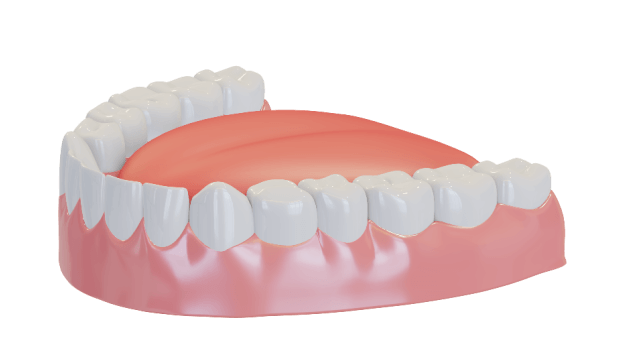What is a dental bridge?
A dental bridge is a type of dental work that replaces a tooth or a few consecutive missing teeth. Two dental crowns are placed on the healthy teeth living on either side of the gap left by your lost tooth. A false tooth, or pontic, is attached to the crowns and literally bridges the gap, replacing your missing tooth.


the dental bridges process
Preparation of Abutment Teeth
Your dentist in Greensboro, NC will clean and numb your mouth, and then begin to trim away a thin layer of enamel from the two teeth next to your missing tooth. These are known as “abutment teeth” and they will hold your crowns. Your bridge will permanently attach to these crowns.
Impressions
Once your abutment teeth have been prepared, your dentist will use dental putty and trays to take impressions of your teeth. These impressions will be used by a technician at a dental lab to build your dental bridge.
Temporary Bridge
Depending on your needs, your dentist will place a temporary resin bridge to protect your prepared abutment teeth, or two temporary dental crowns. Either way, your prepared teeth will be covered and protected until your permanent bridge can be placed.
Bridge Check & Adjustment
Once your permanent bridge is ready, usually within a few weeks, you’ll come into the office to have the bridge checked for proper fit. Minor adjustments may be made by your Greensboro dentist, if necessary, to ensure that your bridge looks and feels natural. If the bridge requires larger adjustments, it will be sent back to the lab for further refinement.
Permanent Placement
Once you and your dentist have determined that the fit of your bridge feels right, they will use powerful dental cement to attach it permanently to your abutment teeth, restoring your smile and your bite.

dental bridge Treatment Options in Greensboro, nc
Traditional dental bridges are made out of two crowns, which are attached permanently to “abutment teeth.” These are the healthy teeth located next to one or more missing teeth within your mouth. Between these teeth, a metal framework is used to suspend one or more “pontics” (false teeth). These false teeth literally “bridge” the gap between your missing teeth, restoring your smile.
Unlike a traditional fixed bridge, which supports your bridge using two abutment teeth, a cantilever bridge uses only a single tooth to support your bridge. In this type of bridge, a natural tooth is trimmed next to your missing tooth. Then, a bridge is made that consists of a single crown and an artificial tooth. The crown is attached to your abutment tooth, and then the artificial tooth is suspended in the gap where your missing tooth used to be, restoring your smile.
Cantilever bridges are less invasive than traditional bridges, since only one tooth has to be trimmed, and they are usually less expensive than traditional bridges. However, you must have a healthy mouth to get a cantilever bridge, and they typically can only be used in a few areas of the mouth.
A Maryland bridge does not require any removal of enamel or preparation of the adjacent teeth. In this treatment, a false tooth is built using a metal framework with “wings” that attach to the adjacent teeth. These “wings” are attached to the backs of your teeth using dental cement, holding the false tooth in place and restoring your smile. Maryland bridges are commonly used in the front teeth, and are ideal if you would like to restore your smile without any invasive dental treatment.
Have questions about dental bridges? Find answers here.
How do dental bridges work?
While every type of bridge is different, dental bridges all share similar characteristics, and work in the same way. A bridge is used to attach one or more false teeth to your existing teeth – locking them into place by using dental crowns (fixed and cantilever bridges) or metal “wings” that attach to the rear of your teeth (Maryland bridges).
Because they won’t move or shift, they’re a great alternative to partial dentures. And since they do not require invasive surgery, some patients prefer dental bridges as an alternative to dental implants.
Are dental bridges permanent or removable?
Dental bridges are considered to be a permanent treatment, since they can only be removed by a dental professional and they typically last 10-15 years or longer.
In addition, the natural tooth preparation procedure for your abutment teeth is not reversible. It requires the permanent removal of enamel from one or more of your teeth, so you may want to keep this in mind when deciding whether or not a bridge is right for you.
Can dental bridges be repaired or replaced?
Yes. Dental bridges, just like all dental prostheses, can become damaged over time, or simply worn down from daily use when chewing, biting, smiling, and speaking. Typically, bridges last between 10-20 years, but the expected lifespan of your bridge may be different depending on the type of bridge, how well you care for your teeth, and a few other factors.
What are dental bridges made of?
This varies, depending on the type of dental bridge you choose. However, most dental bridges are made from a combination of a metal framework, which supports the teeth and ensures they’re in the proper place, and one or more porcelain crowns and false teeth. Acrylic teeth are sometimes used for dental bridges, but usually they are only used for temporary bridges, since acrylic is much less durable than porcelain and ceramic materials.
How much do dental bridges cost?
The cost of dental bridges is different for each patient. Factors that may affect the cost of your bridge include your overall oral health, the type of bridge you choose, pre-treatment surgeries (like tooth extraction) and more. The best way to find out how much you’ll pay for a dental bridge is to schedule a consultation with your dentist in Greensboro, NC.
However, dental bridges are usually covered, at least in part, by dental insurance when they’re used to restore missing teeth. Contact your insurance provider to learn more about your coverage.
How Long Will It Take to Get Used to a Dental Bridge?
It can take up to 2 weeks for your dental bridge to settle. However, most people will settle into their bridge within a few days. It’s normal to experience some minor discomfort and swelling immediately after having a dental bridge placed.
Your bite may feel different and you may experience tooth sensitivity. For the first week or so, you should avoid foods at extreme temperatures and rinse your mouth with a saltwater solution to help reduce sore gums.
Anti-inflammatory pain medication can also ease discomfort. If you have tooth sensitivity as a symptom, you should brush your teeth with toothpaste formulated for sensitive teeth or use a desensitizing gel.
While a small adjustment period is normal, if you experience significant discomfort for longer than 2 weeks or it becomes worse with time, you should contact us right away, as you might have an ill-fitting bridge.
Why Do I Need a Dental Bridge?
The most common reason someone would need a dental bridge is that they are missing one or a few teeth. However, a bridge may also be recommended if you have a severely decayed or broken tooth. If these teeth cannot be repaired, they will be extracted and replaced with a dental bridge.
Bridges serve a lot of purposes, including assisting with speaking and chewing. However, a bridge also fills in gaps that cause aesthetic problems with your smile and prevent surrounding teeth from drifting.
When you lose a tooth and fail to replace it, the adjacent teeth will begin to move which can cause orthodontic problems or they may even block the space where your old tooth used to be. This can cause issues down the line if you end up wanting to replace the tooth later because you will now need to undergo orthodontic treatment to make room for the tooth replacement.
What Causes a Dental Bridge to Fail?
There are a few common reasons why dental bridges fail, but the most common reasons include:
- Poor oral hygiene
- Lacking support in abutment teeth
- Poor materials
- Lifestyle
You must practice good oral hygiene to care for your natural teeth and your dental bridge. Just because you have replaced a missing tooth or teeth doesn’t mean you’re protected from tooth decay and gum disease.
You still need to regularly brush, floss, and attend dental appointments. Bridges require meticulous cleaning to prevent bacteria from becoming trapped between the bridge. However, sometimes people try to save money by choosing a cheaper material for their bridge to be fabricated out of.
While this may seem like a good idea at first, this will hurt you in the long run. If you want to invest in your teeth in the long term, you should select the highest quality materials for tooth replacement. Cheaper materials are less durable and prone to chipping.
It’s also important for the abutment teeth that anchor the bridge to be healthy and to have adequate underlying bone support. Both of these things are necessary to avoid bridge failure. If you have weak bone support or unhealthy teeth, you’re better off getting an implant-supported bridge.
Finally, make sure you aren’t subjecting your bridge to constant wear and tear through teeth grinding, using your teeth to chew on objects or packages, and eating hard and sticky foods. Wear a mouthguard if you grind your teeth and focus on chewing softer, safer foods.


